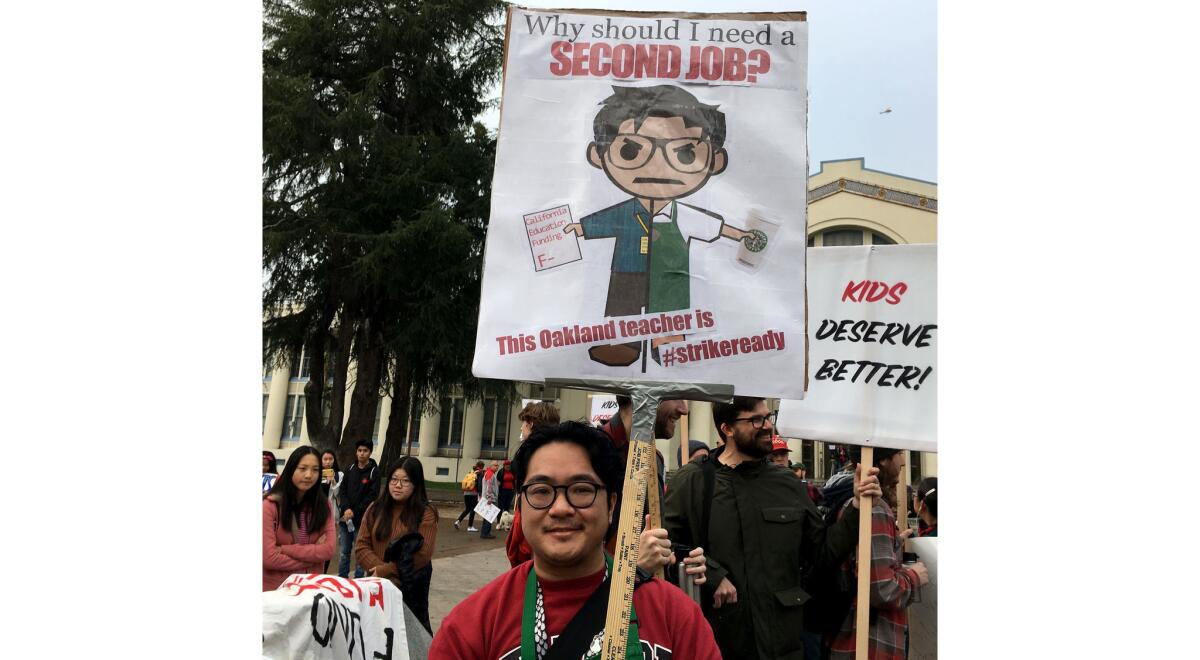Must Reads: Effects of L.A. teachers’ strike ripple across California and beyond

L.A. Unified is the nation’s second-largest school district and receives funding for each of its half a million students. Where is that money coming from?
- Share via
Reporting from Oakland — They didn’t write the lesson plan or instruct Cristopher Bautista’s ninth-grade English class. But members of United Teachers Los Angeles were a powerful presence in the classroom where he works at Oakland Technical High School.
UTLA had taken to the streets 370 miles south, striking for smaller classes, a living wage and more help for their mostly low-income students. Bautista was teaching “Cannery Row,” John Steinbeck’s classic tale of Central Coast haves and have-nots.
“I’ve been teaching about the [Los Angeles] strike to my kids,” Bautista said on Day 5 of the UTLA walkout, which ended last week with the union making incremental gains in wages, classroom sizes and support staff. Bautista sees thematic overlap between Steinbeck’s book and the L.A. work stoppage, which drew international attention. “It’s about class struggles, what people need to get by, low pay. There are parallels.”
The six-day UTLA labor action already has had an impact beyond Southern California, one that is only expected to grow. It has intensified a critical public conversation about how education is paid for, highlighted the effect that charter schools have had on struggling districts and likely will put pressure on Sacramento to funnel more funds to the state’s schools.
The Los Angeles strike also has heightened the possibility that voters could roll back parts of Proposition 13, the landmark 1978 state law curbing property tax increases. A measure to end Proposition 13’s protections for commercial and industrial properties has qualified for the November 2020 ballot.
Its backers predict the strike could improve the new measure’s chances, because the protest underscored the threadbare conditions and overcrowded classrooms in the Los Angeles Unified School District and the widespread public support for teachers and students.
Other school districts are watching too — particularly Oakland Unified, where teachers staged a one-day sickout Jan. 18 in preparation for a possible February strike. They too want smaller classes, fewer charters and wages that will allow them to live in their pricey region without having to drive for Uber or pull espresso shots to pay the bills.
Bautista was part of that wildcat strike. He teaches English and history five days a week and works 15 hours every weekend at a Starbucks in Fremont, Calif. During his lunch breaks Saturdays and Sundays, he corrects papers and plans lessons. During the rally, he wore his green barista apron as he marched with several hundred chanting teachers, parents and young people.
His picket sign said: “Why should I need a second job? This Oakland teacher is #strikeready.”

Bautista tells his students that the union’s struggle is not just a local or state issue: “This is a national matter. This is a turning point in education. You are witnesses. Some of you are participating. This is a big deal.”
In fact, on the same day the Los Angeles walkout ended, the Denver Classroom Teachers Assn. announced that its members had voted to approve their first strike since 1994. And the Fremont Unified District Teachers Assn. in Northern California has reached an impasse in its 2018-19 contract negotiations.
“Winner” and “loser” are difficult concepts to assess in a strike — and resolution — as complicated as the one that roiled the 1,240 schools in the second-biggest district in the nation. UTLA officials wanted limits placed on charter schools; what they got was a little more input regarding shared campuses. Teachers asked for a 6.5% raise; they got 6%.
But L.A. Unified also promised at least some level of class-size reduction, said it will hire 300 nurses and 82 teacher-librarians over the next two years and will add enough counselors to push the student-counselor ratio close to 500:1 — which doesn’t sound like much progress, except that caseloads currently hover between 690 and 890 students per counselor, depending on the school.
The union, however, succeeded in shaping the message that blasted off the picket lines. Part of that message was in sync with the nationwide Red-for-Ed movement, which in 2018 swept across West Virginia, Oklahoma and Arizona; underscored how abysmally teachers are paid; and revealed that in conservative strongholds there is broad public support for education and the people who make it possible.
“The Los Angeles mobilization — and Oakland too — are starting off a slightly different public dialogue than what was caused by the red-state mobilizations,” said John Rogers, professor of education at UCLA.
Yes, teachers in Los Angeles talked about the need for better pay, Rogers said, but the UTLA strike “brought forth how young people are experiencing education and how we as a society need to develop new structures to ensure that young people have the support they need.”
What surprised Rogers was not just how strongly the union message came across, he said, but how ineffective the school district was in trying to persuade the public that it just doesn’t have the money to fix what ails L.A. Unified.
“The district leadership invested hugely in their public relations campaign,” Rogers said. “They brought in additional employees, they engaged with civic leaders, they had regular email chains.
“I didn’t see that from UTLA, but because their message had an underlying resonance, there’s been a connection that was sustained” throughout the strike with the public, he said. “It’s breathtaking how different this conversation is than a decade ago during the recession, when the conversations were so focused on bad teachers.”
The Los Angeles strike also raised the volume on complaints about charter schools, at a time when teachers unions see a sliver of hope that state government might be more receptive to their concerns. Unions believe charter schools have bled important state funding from traditional public campuses.
As with many issues, from immigration to climate change, California is poised to continue setting the terms for a national dialogue about education as a social justice issue. So in recent years the state has become something of an educational battlefield pitting unions and their allies against champions of charters.
Before regaining California’s highest office in 2010, former Gov. Jerry Brown founded two charter schools himself — Oakland Military Institute and Oakland School for the Arts — and he has raised hundreds of thousands of dollars each year to keep them going. As governor, he vetoed multiple bills that would have placed stricter controls on charters.
The power struggle over charter schools has continued to escalate. The California Charter Schools Assn. gave $23 million to the gubernatorial campaign of Antonio Villaraigosa, Gov. Gavin Newsom’s rival in the 2018 primary. Jed Wallace, the group’s former CEO, said before Newsom’s victory that “if Gavin becomes governor, we will face a threat the likes of which we’ve never seen before.”
California has more charter schools and more students enrolled in them than any other state. Twenty percent of the students who live within L.A. Unified’s boundaries attend the city’s 249 charter schools, according to the California Charter Schools Assn. Oakland Unified School District has 83 public schools and has authorized 37 charters, said Keith Brown, president of the Oakland Education Assn.
“The proliferation of charter schools in Oakland has had an impact on student enrollment in our traditional public schools,” Brown said. “It’s put a financial drain on our district. I think the teachers of L.A., by putting the issue of charter schools in their contract demands, really highlight the need for better charter accountability.”
Myrna Castrejon, president of the California Charter Schools Assn., rejects the union analysis and notes that magnet schools have also proliferated in recent years. State law protects charters, she said, and parents deserve to put their children in the schools they believe will suit them best.
That said, the UTLA strike “has raised the profile of education as a worthwhile investment,” Castrejon said. “Now begins the conversation about what are the best ways to do it. It’s not time to say, ‘The strike is over. The issues are resolved.’ It’s an important and significant start to the conversation.”
The question, of course, is where the money will come from to invest in education. Throughout the Los Angeles strike, schools Supt. Austin Beutner cried poverty, arguing that L.A. Unified was spending more money than it was bringing in.
That is where the California Schools and Local Communities Funding Act comes in.
Proposition 13 limits property taxes for homes and businesses to 1% of their taxable value. It also prohibits that taxable value from rising more than 2% each year, no matter how much a property’s market value rises. The longer a person or business owns a piece of property, the less they pay in taxes compared with market value.
What the new ballot measure would do is strip that protection from commercial and industrial properties while leaving residential properties untouched. Its proponents estimate that the measure would bring in $11 billion each year to be split among K-12 education, community colleges and local government bodies.
How much would that bring in to primary and secondary schools in Los Angeles County? An estimated $1.375 billion each year.
Veronica Carrizales is policy and campaign director for California Calls, a statewide alliance of community organizations that is pushing for the new measure, which is also known as “split-roll.” Like many analysts, she argues that the origins of the recently ended strike go back to Proposition 13.
The 1978 measure “caused massive disinvestment of local government and public education,” she said. “It did this by creating a loophole for large commercial and industrial corporations that have essentially avoided paying their fair share.”
Jon Coupal, president of the Howard Jarvis Taxpayers Assn., calls that “an urban myth.” His organization is behind Proposition 13 and plans an expensive and vigorous campaign to beat back any changes to it.
If the ballot measure passes, Coupal said, “citizen taxpayers … will end up paying more for the goods and services they buy,” and L.A. Unified will be no better off.
“This school district is the nation’s poster child for mismanagement,” he said.
Joshua Pechthalt, president of the California Federation of Teachers, said the $5 billion or so that will flow toward education if the new ballot measure passes is a significant amount of money.
“But I don’t think it’s enough money,” he said. “I think other things will have to be done to move California and LAUSD into one of the top states in the nation in terms of per-pupil spending and class size.”
It is, however, a start. Getting the measure passed will be a big lift, but the public response to the UTLA strike is a hopeful sign, he said.
“I think parents have, by their solidarity and their vocal support for UTLA, shown they want to see lower class size, want to see art and music restored for every school, want to see a nurse in every school,” he said. “I think this is a very helpful first step.”
More to Read
Sign up for Essential California
The most important California stories and recommendations in your inbox every morning.
You may occasionally receive promotional content from the Los Angeles Times.











